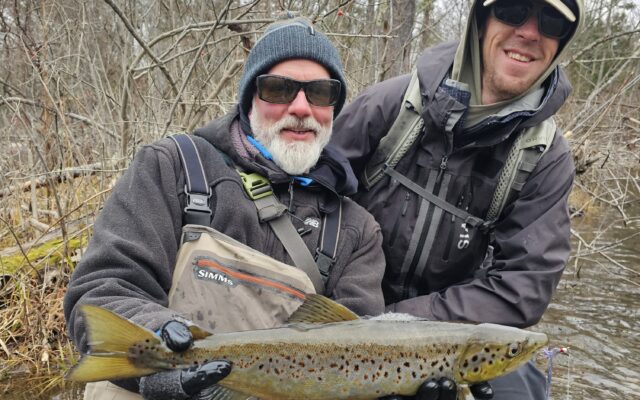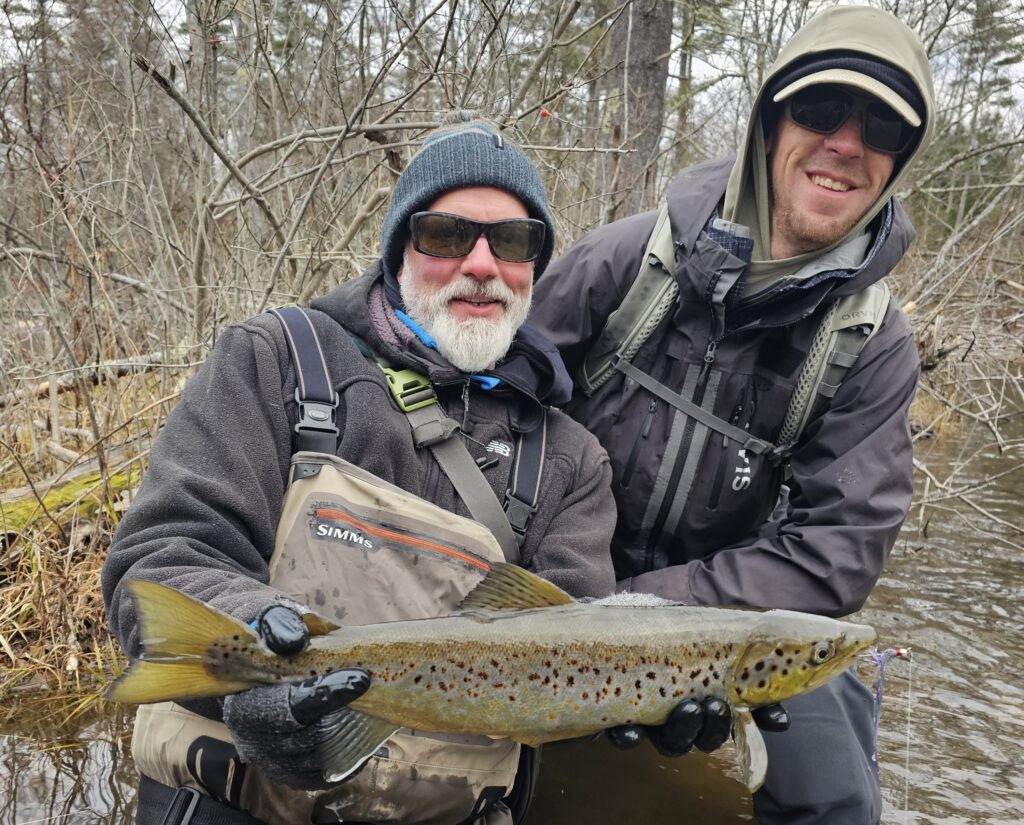
The case for fly fishing in the dead of winter
By Kevin McKay, Maine Fishing Adventures
It was 4:30 a.m. on a winter day with a biting temperature of 22 degrees. The high would reach only 34 degrees, but the forecast promised no wind — a rare gift in winter.
Most anglers had put their fly rods away, transitioning to ice fishing, a sport growing on me but far from my passion. My friend and guide, Brandon Bichrest of maineflyguide.com, was keen to try something bold: catching a pike on the fly in winter.
The odds were slim, but the challenge was irresistible.

FLY FISHING — Brandon Bichrest, left, and BDN Outdoors contributor Kevin McKay show their December fly fishing catch.
We made plans and the night before, Brandon texted me that he might have to cancel because his son was sick and he might need to stay home. He told me to bring my trout rod and flies just in case we could fish.
He had a backup plan: a spot rumored to hold massive salmon due to a mix-up between a dam keeper and a biologist. It was a long shot, but worth exploring.
I reached out to my son Jax, who would meet me at 6:30 a.m., and told him to pack his trout rod. I had the pike flies and seven-weight rods covered. Just as I reached Jax, Brandon texted again — his son was going to school.
The trip was on, and we had two hours to meet him at the boat launch.
By the time we arrived, the air temperature was 28 degrees. Brandon had already launched his new boat and was waiting for us. Soon we were jetting upriver, chasing one of Maine’s premier predators: northern pike.
We stopped, stripped out our lines and began casting. It didn’t take long for action. Jax shouted, “Fish on!” But as quickly as it happened, the fish was gone. At first, he thought it was a snag, but then it started to move.
Pike fishing requires a strong strip strike and often a second hook set to penetrate the fishes’ hard mouths. Lesson learned, we got back to casting, talking about how Maine should manage pike as a trophy fishery instead of encouraging anglers to kill them.
Brandon shared that he had heard pikes don’t typically breed until they’re around 11 years old. Removing the older fish, he explained, forces younger generations to spawn earlier, leading to a population boom — exactly the opposite of what the state is trying to do.
I had also heard that killing the biggest fish allows younger ones to mass-produce, flooding the system with even more fish. Larger pike, on the other hand, help keep the population in check by preying on smaller fish.
Either way, managing pike as a trophy fishery would attract more anglers, boost guide bookings, fill lodges and support local restaurants — a win for Maine’s tourism industry.
We fished hard until 11:30 a.m., but the pike remained elusive. With an hour’s drive to the salmon and trout spot, we decided to make the move.
We met Brandon at the river. As we rigged our rods and donned waders, another fly fisherman walked up. He reported landing a few nice salmon around 21 inches and suggested using tiny midge patterns. As Brandon chatted with the angler, whom he’d guided before, Jax and I headed to the water.
I soon spotted a large salmon, around 18 inches, that rose to inspect my fly but did not commit. Frustrated but determined, Jax and I hiked upriver in search of more fish.
We emerged from the woods and scanned the water. On the opposite side, near a gravel bar, I spotted a big salmon in about a foot of water, with a brook trout sliding in behind it.
My heart raced as I waded into position, careful not to spook them.
The advantage of sight fishing is being able to observe how fish react to your fly. Unfortunately, after several fly changes, I accidentally foul-hooked the salmon and snapped my leader while trying to release it.
We pressed on, moving upriver to a favorite run of mine.
As we approached the run, I recognized a figure on the far bank. “Dan?” I shouted, and sure enough, it was my buddy. He crossed over to chat and mentioned landing a few big salmon and trout.
The four of us — Brandon, Dan, Jax and I — focused on a stretch of water where brook trout and salmon began to appear. Dan eventually headed home, and I tied on a soft hackle streamer I’d recently tied. The trout reacted to the fly but refused to commit.
Brandon moved downstream, but before he’d gone 10 feet, I hooked into a massive landlocked salmon. His intel had paid off, and I was about to land my first December fish — a beauty more than 20 inches long.
The three of us continued fishing upriver for another hour. Jax landed a salmon, and we each hooked into a few more but couldn’t bring them to the net.
Don’t pack away your fly rod just because it’s cold and the snow has fallen. Winter fishing often means fewer people and some incredible opportunities.
Maine does an excellent job stocking rivers, providing hardy anglers with the chance to chase trout and salmon long after most people have moved indoors.
Sometimes, the best days are the coldest ones.